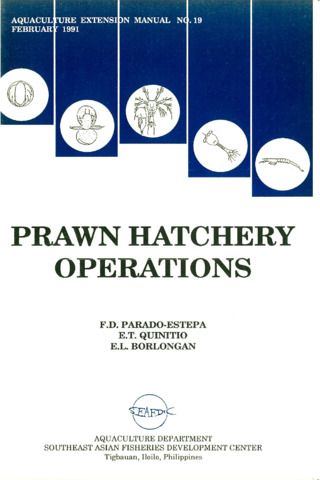Perlihatkan publikasi sederhana
Utilization of feed pea, Pisum sativum, meal as protein source in practical diets for juvenile shrimp, Penaeus monodon
| dc.contributor.author | Bautista-Teruel, Myrna N. | |
| dc.contributor.author | Eusebio, Perla S. | |
| dc.contributor.author | Welsh, Timothy P. | |
| dc.date.accessioned | 2014-03-25T07:08:35Z | |
| dc.date.available | 2014-03-25T07:08:35Z | |
| dc.date.issued | 2003 | |
| dc.identifier.citation | Bautista-Teruel, M. N., Eusebio, P. S., & Welsh, T. P. (2003). Utilization of feed pea, Pisum sativum, meal as a protein source in practical diets for juvenile tiger shrimp, Penaeus monodon. Aquaculture, 225(1-4), 121-131. | en |
| dc.identifier.issn | 0044-8486 | |
| dc.identifier.uri | http://hdl.handle.net/10862/1952 | |
| dc.description.abstract | The potential of feed pea meal as an alternative protein source to soybean meal in practical diets for the juvenile tiger shrimp, Penaeus monodon, was assessed in several experiments. Six isonitrogenous diets were formulated to contain 40% protein. Protein from the feed pea meal replaced 0%, 20%, 40%, 60%, 80%, and 100% of the protein from defatted soybean meal in the diets. These values were equivalent to 0%, 5%, 10%, 15%, 20%, 25%, respectively, of the total protein in the diet. A negative control with no protein sources was added to the treatments. Twelve shrimp post-larvae with an average weight of 0.02±0.01 g were randomly assigned in thirty-five 60-l oval tanks equipped with a flow-through seawater system. The shrimp were fed the formulated diets at a daily feeding rate of 20–25% body weight for 90 days in five replicate samples. No significant differences (P>0.05) were observed in weight gain, feed intake, feed conversion ratio (FCR) and protein efficiency ratio (PER) of shrimp fed diets 0 up to the highest level of replacement. Weight gain of shrimp fed the negative control was, however, significantly lower (P<0.05) compared to the rest of the treatments. Specific growth rates (SGR) of shrimp showed likewise no significant differences among treatments except for the negative control. Survival of shrimp for all treatments ranged between 75% and 100%. The apparent dry matter (ADMD) and protein (APD) digestibilities of the dry feed pea in P. monodon were high at 73.38±4.98 and 92.74±2.62, respectively. Digestibility coefficients for dry matter and protein for the feed pea meal-based diets increased with increasing level of feed pea replacement. There were no significant differences in whole body composition (dry matter, protein, lipid, ash, fiber) of shrimp fed the various diets with feed pea replacement. Pellet water stability was similar for all diets even up to the highest level of replacement. The results have demonstrated that feed pea meal has a very good potential as a substitute protein source up to 100% of the protein from defatted soybean meal, which is equivalent to 25% of the total protein in the diet. An inclusion level of up to 42% in the juvenile shrimp P. monodon practical diet did not manifest any adverse effects on growth, feed intake, FCR, survival, body composition, and digestibility coefficients for dry matter and protein of the shrimp. | en |
| dc.description.sponsorship | The authors acknowledge the United States Department of Agriculture and USA Dry Pea and Lentil Council for the research grant; M. Mallare and J. Vera Cruz for the technical assistance; F. Jarder for the proximate analysis; J. Bangcaya and M. Arnaiz for the amino acid analysis. | en |
| dc.language.iso | en | en |
| dc.publisher | Elsevier | en |
| dc.subject | Penaeus monodon | en |
| dc.subject | Pisum sativum | en |
| dc.title | Utilization of feed pea, Pisum sativum, meal as protein source in practical diets for juvenile shrimp, Penaeus monodon | en |
| dc.type | Article | en |
| dc.identifier.doi | 10.1016/S0044-8486(03)00284-9 | |
| dc.citation.volume | 225 | |
| dc.citation.issue | 1-4 | |
| dc.citation.spage | 121 | |
| dc.citation.epage | 131 | |
| dc.citation.journalTitle | Aquaculture | en |
| seafdecaqd.library.callnumber | VF SJ 0748 | |
| seafdecaqd.databank.controlnumber | 2003-24 | |
| dc.subject.asfa | diet | en |
| dc.subject.asfa | digestibility | en |
| dc.subject.asfa | feed composition | en |
| dc.subject.asfa | feeding experiments | en |
| dc.subject.asfa | food consumption | en |
| dc.subject.asfa | growth rate | en |
| dc.subject.asfa | proteins | en |
| dc.subject.asfa | shrimp culture | en |
| dc.subject.asfa | juveniles | en |
| dc.subject.asfa | nutrition | en |
| dc.subject.scientificName | Penaeus monodon | en |
Files in this item
| Files | Size | Format | View |
|---|---|---|---|
|
There are no files associated with this item. |
|||
Publikasi ini ada di koleksi berikut
-
Journal Articles [1229]
These papers were contributed by Department staff to various national and international journals.




